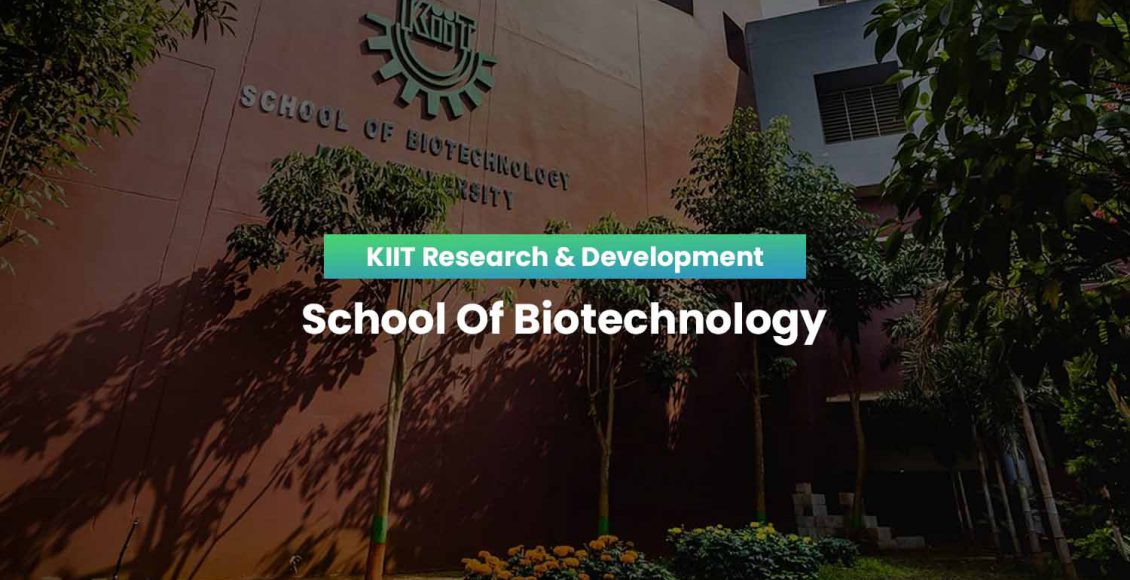School of Biotechnology (Jun – Jul 2022)
PhD Awards

Student’s Name: Dr. Tanmay Nayak
Supervisor’s Name: Dr. Vishakha Raina, School of Biotechnology
Thesis Title: Bioremediation of Chlorpyrifos Using Paddy Field Bacterial Isolates: Genomic Insights and Combinatorial Approach towards Field Application
| Abstract: The study highlights the potential of a bacterial isolate Ochrobactrum sp. CPD-03, in the degradation of Chloropyrifos, an organophosphate pesticide which could be beneficial for the agricultural soil improvement. The genome studies validated the key insights of the responsible genes and also draw information for a possible metabolic pathway behind CP degradation metabolism. This study also highlights the use of combinatorial process such as (a) biostimulation along with bioaugmentation with supplementation of carrier material and (b) photo-Fenton process followed by bacterial degradation for achieving enhanced CP degradation in waste water treatment. |

Student’s Name: Dr. Ananya Banerjee
Supervisor’s Name: Dr. Srinivas Patnaik, School of Biotechnology
Thesis Title: Targeting Cancer Stem Cells to Eradicate Ovarian Cancer
Abstract:
Ovarian cancer is one of the most lethal forms of malignancies and is the fifth leading cause of cancer related deaths in women. Most women are diagnosed with the ovarian cancer at an advanced stage and despite complete response with surgery and platinum-based chemotherapy, the majority of the cases relapse, and the recurrent tumors become resistant to the initial drug regimen. The primary reason behind tumor recurrence and chemo resistance has been elucidated to be the existence of a sub-population within the tumor cells, referred to as the cancer stem like cells or ‘Cancer stem cells’ (CSCs). This subgroup of cells has been characterized with inherent properties of self-renewal, invasion, cell migration and differentiation, and is found in leukemias and most solid tumors. The challenge lies in identifying these CSCs and establishing a universal method to isolate them as cancers of different epithelial origin are seen to display a differential expression of CSC biomarkers. The variation in the expression of CSC biomarkers were observed between tumors of same epithelial origin from different patients and also within the same tumor in a single patient. Owing to this diverse range of intra-tumoral and inter-tumoral heterogeneity and constantly evolving mechanisms of the CSCs to evade the host’s immune response and potentially toxic effects of chemotherapy, it has become increasingly important to understand the survival strategy of the CSCs. In the current study, we focused on the ovarian cancer stem cells, and their surviving mechanisms. A major part of this study shows the high expression of miR-328 in ovarian CSCs and elucidates the underlying mechanism of how this phenomenon contributes to stem cell survival and favors disease progression. The other part of the study highlights the importance of Estrogen Receptor Beta (ERß) and its therapeutic implications in depleting ovarian cancer stem cells.

Student’s Name: Dr. Parej Nath
Co-Supervisor’s Name: Dr. Srinivas Patnaik, School of Biotechnology
Thesis Title: Understanding the Role of IRGM in Regulating Innate Immunity
Abstract
Activation of the type I interferon response is extensively connected to the pathogenesis of autoimmune diseases. Loss of function of Immunity Related GTPase M (IRGM) has also been associated with several autoimmune diseases, but its mechanism of action is unknown. In this study, we found that IRGM is a master negative regulator of the interferon response. Several nucleic acid-sensing pathways leading to interferon-stimulated gene expression are highly activated in IRGM knockout mice and human cells. In this study, we show that IRGM interacts with nucleic acid sensor proteins, including cGAS and RIG-I, and mediates their p62-dependent autophagic degradation to restrain interferon signaling. Further, IRGM deficiency results in defective mitophagy leading to the accumulation of defunct leaky mitochondria that release cytosolic DAMPs and mtROS. Hence, IRGM deficiency increases not only the levels of the sensors but also those of the stimuli that trigger the activation of the cGAS-STING and RIG-I-MAVS signaling axes, leading to robust induction of IFN responses. The flipside effect of high type I interferon response is protection against invading viruses. However, the role of human IRGM during viral infection has remained unclear. We have shown here that IRGM expression is increased upon viral infection. IFN responses induced by viral PAMPs are negatively regulated by IRGM. Conversely, IRGM depletion results in robust induction of key viral restriction factors including IFITMs, APOBECs, SAMHD1, tetherin, viperin, and HERC5/6. Additionally, antiviral processes such as MHC-I antigen presentation and stress granule signaling are enhanced in IRGM-deficient cells, indicating a robust cell-intrinsic antiviral immune state. Consistently, IRGM-depleted cells are resistant to the infection with seven viruses from five different families, including Togaviridae, Herpesviridae, Flaviviridae, Rhabdoviridae, and Coronaviridae. Moreover, we show that Irgm1 knockout mice are highly resistant to chikungunya virus (CHIKV) infection. Taken together, this study defines the molecular mechanisms by which IRGM maintains interferon homeostasis and protects from autoimmune diseases. Also, it highlights IRGM as a broad therapeutic target to promote defense against a large number of human viruses, including SARS-CoV-2, CHIKV, and Zika virus.
Journal Papers
1. Bhattacharjee, R., Ghosh, S., Nath, A., Basu, A., Biswas, O., Patil, C. R., & Kundu, C. N. (2022). Theragnostic strategies harnessing the self-renewal pathways of stem-like cells in the acute myeloid leukemia. Critical reviews in oncology/hematology, 177, 103753. https://doi.org/10.1016/j.critrevonc.2022.103753 (IF: 6.312)
Abstract
Acute myelogenous leukemia (AML) is a genetically heterogeneous and aggressive cancer of the Hematopoietic Stem/progenitor cells. It is distinguished by the uncontrollable clonal growth of malignant myeloid stem cells in the bone marrow, venous blood, and other body tissues. AML is the most predominant of leukemias occurring in adults (25%) and children (15-20%). The relapse after chemotherapy is a major concern in the treatment of AML. The overall 5-year survival rate in young AML patients is about 40-45% whereas in the elderly patients it is less than 10%. Leukemia stem-like cells (LSCs) having the ability to self-renew indefinitely, repopulate and persist longer in the G0/G1 phase play a crucial role in the AML relapse and refractoriness to chemotherapy. Hence, novel treatment strategies and diagnostic biomarkers targeting LSCs are being increasingly investigated. Through this review, we have explored the signaling modulations in the LSCs as the theragnostic targets. The significance of the self-renewal pathways in overcoming the treatment challenges in AML has been highlighted.
2. Surve, C., Banerjee, A. S. A., Chakraborty, R., Kumar, D., Butti, R., Gorain, M., Parida, S., Kundu, G. C., Shidhaye, S., & Patnaik, S. (2022). Antiproliferative and apoptotic potential of methotrexate lipid nanoparticles in a murine breast cancer model. Nanomedicine (London), 17(11), 753-764. https://doi.org/10.2217/nnm-2021-0446 (IF: 6.096 )
Abstract
Aim: To evaluate the efficacy of novel methotrexate-loaded nanoparticles (MTX-NPs) in vitro and in vivo in the treatment of breast cancer. Materials & methods: MTX-NPs were tested for cellular uptake, cell viability, cell cycle, cellular wound migration and changes in tumor volume using characterized NPs.
Results: The solid lipid NPs (SLNPs) showed strong cellular uptake, increased apoptosis, controlled cytotoxicity at lower IC50 of methotrexate and a sizable reduction in tumor burden.
Conclusion: MTX-NP oral formulation can be a promising candidate in breast cancer treatment with improved cellular uptake and in vivo efficacy.
3. Mohanty, S., Patel, P., Jha, E., Panda, P. K., Kumari, P., Singh, S., Sinha, A., Saha, A. K., Kaushik, N. K., Raina, V., Verma, S. K., & Suar, M. (2022). In vivo intrinsic atomic interaction infer molecular eco-toxicity of industrial TiO2 nanoparticles via oxidative stress channelized steatosis and apoptosis in Paramecium caudatum. Ecotoxicology and Environmental Safety, 241, 113708. https://doi.org/10.1016/j.ecoenv.2022.113708 (IF: 6.291)
Abstract
The ecotoxicological effect of after-usage released TiO2 nanoparticles in aquatic resources has been a major concern owing to their production and utilization in different applications. Addressing the issue, this study investigates the detailed in vivo molecular toxicity of TiO2 nanoparticles with Paramecium caudatum. TiO2 nanoparticles were synthesized at a lab scale using high energy ball milling technique; characterized for their physicochemical properties and investigated for their ecotoxicological impact on oxidative stress, steatosis, and apoptosis of cells through different biochemical analysis, flow cytometry, and fluorescent microscopy. TiO2 nanoparticles; TiO2 (N15); of size 36 ± 12 nm were synthesized with a zeta potential of – 20.2 ± 8.8 mV and bandgap of 4.6 ± 0.3 eV and exhibited a blue shift in UV-spectrum. Compared to the Bulk TiO2, the TiO2 (N15) exhibited higher cytotoxicity with a 24 h LC50 of 202.4 µg/ml with P. Caudatum. The mechanism was elucidated as the size and charge-dependent internalization of nanoparticles leading to abnormal physiological metabolism in oxidative stress, steatosis, and apoptosis because of their influential effect on the activity of metabolic proteins like SOD, GSH, MDA, and catalase. The study emphasized the controlled usage TiO2 nanoparticles in daily activity with a concern for ecological and biomedical aspects.
4. Devi, T. B., Raina, V. & Rajashekar, Y. (2022). A novel biofumigant from Tithonia diversifolia (Hemsl.) A. Gray for control of stored grain insect pests. Pesticide Biochemistry and Physiology, 184, 105116. https://doi.org/10.1016/j.pestbp.2022.105116 (IF: 3.963)
Abstract
For the well-being of human health as well as ecological concerns and the development of insect resistance to conventional chemical insecticides, efforts have increased worldwide, to find eco-friendly, effective and safer insect control agents which are of natural origin. A bioactive biofumigant molecule named dihydro-p-coumaric acid was isolated and characterized from the leaves of Tithonia diversifolia Hemsl. A. Gray following laboratory bioassays against the rice weevil, Sitophilus oryzae L (Coleoptera: Curculionidae); the lesser grain borer, Rhyzopertha dominica F (Coleoptera: Bostrichidae) and the rust-red flour beetle, Tribolium castaneum Herbst (Coleoptera: Tenebrionidae). The isolated compound acted as a fumigant, toxic to adults of stored grain insect pests with LC50 values of 17.86, and 11.49 μg/L (S. oryzae), 19.80 and 10.29 μg/L (R. dominica) and 24.41 and 17.80 μg/L air (T. casatneum) respectively. Further, in vivo data reveal that the percentage of inhibition of acetyl cholinesterase (AChE) was dose-dependent and in vitro results showed potent AChE inhibitor. The isolated compound acts as an efficient biofumigant against the stored grain insect pests and has no adverse effect on seed germination. From this study, we assume that the isolated biofumigant molecule has the ability for used in IPM programs for stored-grain pests because of its biofumigant activity.
5. Jena, B. C., Das, C. K., Banerjee, I., Bharadwaj, D., Majumder, R., Das, S., Biswas, A., Kundu, M., Roy, P. K., Kundu, C. N., & Mandal, M. (2022). TGF-β1 induced autophagy in cancer associated fibroblasts during hypoxia contributes EMT and glycolysis via MCT4 upregulation. Experimental cell research, 417(1), 113195. https://doi.org/10.1016/j.yexcr.2022.113195 (IF: 3.905)
Abstract
The Transforming growth factor-β1 (TGF- β1) in the tumor microenvironment (TME) is the major cytokine that acts as a mediator of tumor-stroma crosstalk, which in fact has a dual role in either promoting or suppressing tumor development. The cancer-associated fibroblasts (CAFs) are the major cell types in the TME, and the interaction with most of the epithelial cancers is the prime reason for cancer survival. However, the molecular mechanisms, associated with the TGF- β1 induced tumor promotion through tumor-CAF crosstalk are not well understood. In the Reverse Warburg effect, CAFs feed the adjacent cancer cells by lactate produced during the aerobic glycolysis. We hypothesized that the monocarboxylate transporter, MCT4 which is implicated in lactate efflux from the CAFs, must be overexpressed in the CAFs. Contextually, to explore the role of TGF- β1 in the hypoxia-induced autophagy in CAFs, we treated CoCl2 and external TGF- β1 to the human dermal fibroblasts and L929 murine fibroblasts. We demonstrated that hypoxia accelerated the TGF- β1 signaling and subsequent transformation of normal fibroblasts to CAFs. Moreover, we elucidated that synergistic induction of autophagy by hypoxia and TGF- β1 upregulate the aerobic glycolysis and MCT4 expression in CAFs. Furthermore, we showed a positive correlation between glucose consumption and MCT4 expression in the CAFs. Autophagy was also found to be involved in the EMT in hypoxic CAFs. Collectively, these findings reveal the unappreciated role of autophagy in TME, which enhances the CAF transformation and that promotes tumor migration and metastasis via the reverse Warburg effect.
6. Santos, F. H., Panda, S, Ferreira, D. C. M., Dey, G, Molina, G., & Pelissari, F.M. (2022). Targeting infections and inflammation through micro and nano-nutraceuticals. Food Bioscience, 49, 101891. https://doi.org/10.1016/j.fbio.2022.101891 (IF: 4.24)
Abstract
Nowadays, the pharma and food industries have been gearing up to meet the urgent need for anti-infective and anti-inflammatory nutritional formulations. In this way, several nutraceutical compounds are being re–evaluated due to their established bioactivities. Few compounds have been or may be efficiently targeted against infections, inflammatory conditions and for immune modulation. However, for successful management of these metabolic conditions, the nutraceuticals need to be designed into effective nutritional formulations. Over recent years there have been tremendous progress in the re-engineering of structurally delivery vehicles which provide stability, enhance bioaccessibility and bioavailability of these compounds. In this perspective, this review focuses on the structural and functional aspects of several such bio-based delivery vehicles like the micro and nano particles, nano-emulsions and liposome-based models. The aim is to bring forth recent information on the efficacious nutraceuticals and the suitable delivery vehicles which would be useful against infections and inflammatory conditions.
7. Singh, K., Verma, S. K., Patel, P., Panda, P. K., Sinha, A., Das, B., Raina, V., Suar, M., & Ray, L. (2022). Hydoxylated β- and δ-Hexacholorocyclohexane metabolites infer influential intrinsic atomic pathways interaction to elicit oxidative stress-induced apoptosis for bio- toxicity. Environmental Research, 212 (Pt D):113496. https://doi.org/10.1016/j.envres.2022.113496 (IF: 6.498)
Abstract
Hexachlorocyclohexane (HCH) has been recognized as an effective insecticide to protect crops against grasshoppers, cohort insects, rice insects, wireworms, and other agricultural pests and; for the control of vector-borne diseases such as malaria. It is a cyclic, saturated hydrocarbon, which primarily exists as five different stable isomers in the environment. Though the use of HCH is banned in most countries owing to its adverse effects on the environment, its metabolites still exist in soil and groundwater, because of its indiscriminate applications. In this study, a dose-dependent toxicity assay of the HCH isomers isolated from soil and water samples of different regions of Odisha, India was performed to assess the in vivo developmental effects and oxidative stress in zebrafish embryos. Toxicity analysis revealed a significant reduction in hatching and survivability rate along with morphological deformities (edema, tail malformations, spinal curvature) upon an increase in the concentration of HCH isomers; beta isomer exhibiting maximum toxicity (p < 0.05). Oxidative stress assay showed that ROS and apoptosis were highest in the fish exposed to β-2 and δ-2 isomers of HCH in comparison to the untreated one. Zebrafish proved to be a useful biological model to assess the biological effects of HCH isomers. In addition, the results suggest the implementation of precautionary measures to control the use of organochlorine compounds that can lead to a decrease in the HCH isomers in the field for a healthier environment.
8. Tarafdar, S., & Chowdhary, G. (2022). Translating the Arabidopsis thaliana Peroxisome Proteome insights to Solanum lycopersium: Consensus versus Diversity. Frontiers in cell and Developmental Biology, 10, 909604. https://doi.org/10.3389/fcell.2022.909604 (IF: 5.69)
Abstract
Peroxisomes are small, single-membrane specialized organelles present in all eukaryotic organisms. The peroxisome is one of the nodal centers of reactive oxygen species homeostasis in plants, which are generated in a high amount due to various stress conditions. Over the past decade, there has been extensive study on peroxisomal proteins and their signaling pathways in the model plant Arabidopsis thaliana, and a lot has been deciphered. However, not much impetus has been given to studying the peroxisome proteome of economically important crops. Owing to the significance of peroxisomes in the physiology of plants during normal and stress conditions, understating its proteome is of much importance. Hence, in this paper, we have made a snapshot of putative peroxisomal matrix proteins in the economically important vegetable crop tomato (Solanum lycopersicum, (L.) family Solanaceae). First, a reference peroxisomal matrix proteome map was generated for Arabidopsis thaliana using the available proteomic and localization studies, and proteins were categorized into various groups as per their annotations. This was used to create the putative peroxisomal matrix proteome map for S. lycopersicum. The putative peroxisome proteome in S. lycopersicum retains the basic framework: the bulk of proteins had peroxisomal targeting signal (PTS) type 1, a minor group had PTS2, and the catalase family retained its characteristic internal PTS. Apart from these, a considerable number of S. lycopersicum orthologs did not contain any “obvious” PTS. The number of PTS2 isoforms was found to be reduced in S. lycopersicum. We further investigated the PTS1s in the case of both the plant species and generated a pattern for canonical and non-canonical PTS1s. The number of canonical PTS1 proteins was comparatively lesser in S. lycopersicum. The non-canonical PTS1s were found to be comparable in both the plant species; however, S. lycopersicum showed greater diversity in the composition of the signal tripeptide. Finally, we have tried to address the lacunas and probable strategies to fill those gaps.
9. Kumar, G., Das, C., Acharya, A., Bhal, S., Joshi, M., Kundu, C. N., Choudhury, A. R., & Guchhait, S. K. (2022). Organocatalyzed umpolung addition for synthesis of heterocyclic-fused arylidene-imidazolones as anticancer agents. Bioorganic & medicinal chemistry, 67, 116835. https://doi.org/10.1016/j.bmc.2022.116835 (IF: 3.641)
Abstract
A strategy of “Nature-to-new” with iterative scaffold-hopping was considered for investigation of privileged ring/functional motif-elaborated analogs of natural aurones. An organocatalyzed umpolung chemistry based method was established for molecular-diversity feasible synthesis of title class of chemotypes i.e. (Z)-2-Arylideneimidazo[1,2-a]pyridinones and (Z)-2-Arylidenebenzo[d]imidazo[2,1-b]thiazol-3-ones. Various biophysical experiments indicated their important biological properties. The analogs showed characteristic anticancer activities with efficiency more than an anticancer drug. The compounds induced apoptosis with arrest in the S phase of the cell cycle regulation. The compounds’ significant effect in up/down-regulation of various apoptotic proteins, an apoptosis cascade, and the inhibition of topoisomerases-mediated DNA relaxation process was identified. The analysis of the structure-activity relationship, interference with biological events and the drug-likeness physicochemical properties of the compounds in the acceptable window indicated distinctive medicinal molecule-to-properties of the investigated chemotypes.
10. Lin, S-C., Li Y., Hu F-Y., Wang C-L., Kuang Y-H., Sung C-L., Tsai S-F., Yang Z-W., Li C. P., Huang S-H., Liao C-T., Hechanova S.L., Jena K.K., & Chuang W-P. (2022). Effect of nitrogen fertilizer on the resistance of rice near-isogenic lines with BPH resistance genes. Botanical Studies, 63, 16. https://doi.org/10.1186/s40529-022-00347-8 (IF: 2.7)
Abstract
Background: Nitrogen is an essential macronutrient for plant growth and development. Crops with a high nitrogen input usually have high yields. However, outbreaks of brown planthoppers (Nilaparvata lugens; BPH) frequently occur on rice farms with excessive nitrogen inputs. Rice plants carrying BPH resistance genes are used for integrated pest management. Thus, the impact of nitrogen on the resistance of rice near-isogenic lines (NILs) with BPH resistance genes was investigated. Results: We tested these NILs using a standard seedbox screening test and a modified bulk seedling test under different nitrogen treatments. The amount of nitrogen applied had an impact on the resistance of some lines with BPH resistance genes. In addition, three NILs (NIL-BPH9, NIL-BPH17, and NIL-BPH32) were further examined for antibiosis and antixenosis under varying nitrogen regimes. The N. lugens nymph population growth rate, honeydew excretion, female fecundity, and nymph survival rate on the three NILs were not affected by different nitrogen treatments except the nymph survival rate on NIL-BPH9 and the nymph population growth rate on NIL-BPH17. Furthermore, in the settlement preference test, the preference of N. lugens nymphs for IR24 over NIL-BPH9 or NIL-BPH17 increased under the high-nitrogen regime, whereas the preference of N. lugens nymphs for IR24 over NIL-BPH32 was not affected by the nitrogen treatments. Conclusions: Our results indicated that the resistance of three tested NILs did not respond to different nitrogen regimes and that NIL-BPH17 exerted the most substantial inhibitory effect on N. lugens growth and development.
11. Dhal, A. K., Young, G. M., Yun, S., & Mahapatra, R. K. (2022). Computational analysis of Elongation Factor-2 (EF-2) protein of Cryptosporidium parvum for identification of therapeutics. Biologia, 77(5), 1447–1457. https://dx.doi.org/10.1007/s11756-022-01030-w (IF: 1.35)
Abstract
Cryptosporidium parvum (Cp) is an obligate intracellular apicomplexan parasite that infects the intestinal tract of mammals. C. parvum oocysts are transmitted mainly through contact with contaminated water and then reproduce sexually and asexually in the intestinal lining cells, resulting in diarrhea. Elongation Factor 2 (EF-2) of C. parvum is a ubiquitous eukaryotic protein that is essential for protein synthesis and is regarded as a drug target for therapeutic intervention. EF-2 catalyses the translocation of peptidyl-tRNA from the amino-acyl site to the peptidyl site of the ribosome during the elongation phase of protein synthesis. In this study, the sequence similarity between the template structures and the EF-2 protein of C. parvum was considered for the determination of the three-dimensional structure of the target protein through the homology modelling approach by MODELLER v9.21 software. By using different computer-aided drug designing techniques such as structure and ligand-based studies, the potential inhibitor molecules were enlisted. Compounds like CHEMBL1784973 and ZINC_03830706 are reported as the best inhibitors against the CpEF-2 protein. Furthermore, the reliability of the binding mode of the hit molecule ZINC_03830706 is validated through a complex MD simulation study for a time frame of 100 ns in an aqueous environment. The compound identified from the computational approach can be considered through experimental studies in the future.
12. Arega, A. M., Dhal, A. K., Nayak, S., & Mahapatra, R. K. (2022). In silico and in vitro study of Mycobacterium tuberculosis H37Rv uncharacterized protein (RipD): an insight on tuberculosis therapeutics. Journal of Molecular Modeling, 28(6), 171. https://doi.org/10.1007/s00894-022-05148-1 (IF: 1.81)
Abstract
Tuberculosis caused by Mycobacterium tuberculosis (Mtb) is responsible for the highest global health problem, with the deaths of millions of people. With prevalence of multiple drug resistance (MDR) strains and extended therapeutic times, it is important to discover small molecule inhibitors against novel hypothetical proteins of the pathogen. In this study, a virtual screening protocol was carried out against MtbH37Rv hypothetical protein RipD (Rv1566c) for the identification of potential small molecule inhibitors. The 3D model of the protein structure binding site was used for virtual screening (VS) of inhibitors from the Pathogen Box, followed by its validation through a molecular docking study. The stability of the protein-ligand complex was assessed using a 150 ns molecular dynamics simulation. MM-PBSA and MM-GBSA are the two approaches that were used to perform the trajectory analysis and determine the binding free energies, respectively. The ligand binding was observed to be stable across the entire time frame with an approximate binding free energy of -22.9916 kcal/mol. The drug-likeness of the inhibitors along with a potential anti-tuberculosis compound was validated by ADMET prediction software. Furthermore, a CFU inhibition assay was used to validate the best hit compound’s in vitro inhibitory efficacy against a non-pathogenic Mycobacterium smegmatis MC2155 under low nutrient culture conditions. The study reported that the compound proposed in our study (Pathogen Box ID: MMV687700) will be useful for the identification of potential inhibitors against Mtb in future.
Patent Filed/Published/Granted
- Dr. Sung-Ryul Kim, Dr. Prahalada G.D, Dr. Kshirod K. Jena. Patent title: Methods of increasing outcrossing rates in gramineae (USA patent publication No. WO/2022/038536 A1)
Abstract
A method of producing a Gramineae plant, the method comprising (a) expressing in a Gramineae plant or plant cell expression of a polynucleotide encoding OLLS1 as set forth in SEQ ID NO: 12 or 13 or a homolog thereof capable of increasing stigma length of the Gramineae plant, wherein when the expressing is by crossing the plant with another plant expressing the polypeptide, selecting for stigma length is performed using markers located between ST87 to ST99; and (b) growing or regenerating the plant.
2. Mr. Rahul Chatterjee, Dr. Rahul Modak, Dr. Vishakha Raina, Dr. Mrutyunjay Suar Ms. Ritu Ghosh, Dr. Gurmeet Singh. Patent Name: An enzyme and formulation thereof for reducing formation of acrylamide in food processing (Indian patent filed).
Abstract
An enzyme and formulation thereof for reducing formation of acrylamide in food processing.


